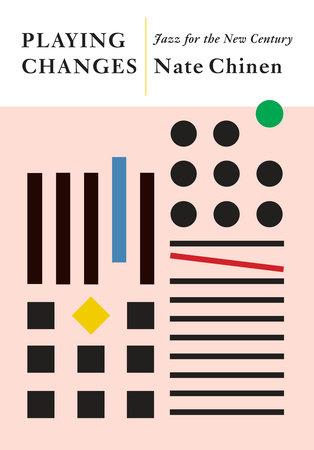Book Review: “Playing Changes” — Redefining Jazz
By Steve Provizer
This volume is clearly critic Nate Chinen’s resounding response to the “jazz is dead” chant.
Playing Changes: Jazz for the New Century by Nate Chinen. Penguin Random House, Pantheon, 288 pages, $27.95.

The title Playing Changes is, of course, a pun, referring to both non-permanence and to chord changes. Fair enough, although I would nominate a phrase from the book’s Afterword as a better alternative: “The Spirit of Multiplicity.” This volume is clearly Chinen’s resounding response to the “jazz is dead” chant. Instead of losing its way (and its audience), the author argues that jazz has always discovered creative ways to rejuvenate itself. As Chinen neatly puts it: “Instead of a push for definition and one prevailing style, we have boundless permutations without fixed parameters.”
We’ve heard the “demise-of-jazz” trope before, and Chinen traces the most recent version here. Following the jazz fractures of the late ’50s-’60s, there was a process of canonization in the ’70s propelled by the Smithsonian Jazz Collection. In the ’80s, jazz was seen as “stylish but inert,” overtaken by rock, soul, disco, and funk. Then came the rise of the Wynton Marsalis, Albert Murray, and Stanley Crouch contingent, the Young Lions and Jazz at Lincoln Center (JALC). This group reasserted the importance of lineage, aesthetic conservation, and the centrality of “swing.” Meantime, a thriving alternative scene was happening at the Knitting Factory and other small spaces in NYC and in other cities, particularly Chicago. There was also a tremendous growth in interest in jazz internationally. The media picked up on the infra-fighting and superficially characterized it as “uptown” versus “downtown.” I see in this media-fueled battle echoes of the conflict between beboppers and “moldy figs” in the ’40s. A comparative allusion to the two events by Chinen might have been instructive.
What Chinen wants us to take away from this more recent tussle is not that bodies were left littered in its wake. He observes that young musicians arriving in the ’90s were inevitably exposed to a multiplicity of approaches; and that, as the buffet expanded, musicians felt less and less as though they had to graze from just one table. They felt free to test their mettle in any number of approaches. One could conclude that, metaphorically speaking, Chinen treats the stand-off as a brushfire that ended up clearing the way for new growth.
Chinen doesn’t buy into dire predictions concerning the ramifications of jazz moving into institutions and the academy. He believes that the music’s pedagogy has actually been democratized in various ways. He takes a provocative look at the Real Book, the fake book (simplified “lead sheets’ of songs in the jazz repertoire) that came out of Berklee College of Music in the ’70s. He solves a mystery that had puzzled me since my earliest days with the Real Book; namely, why some of the charts were scruffy and not overly correct, while others were full and accurate renderings of the tunes. Part of the reason, at least, is that some musicians who were at Berklee at the time — Pat Metheny, Carla Bley, and Steve Swallow — gave copies of their own lead sheets to the compilers of the fake book. Chinen also believes that the play-along-with books, along with the recordings of Jamey Abersold, were also very important. They made it possible for anyone, no matter how isolated from other musicians, to learn to play tunes and to pick up how to improvise with a professional rhythm section.
One possible downside of jazz moving into the academy is the loss of the informal system of mentoring that had served the music for so many generations. Chinen has an exchange with sax player-teacher Billy Pierce at Berklee about this. The musician is somewhat rueful about the development, but Chinen puts as positive spin on it as he can. His descriptions of the mentoring of teachers in various high schools and colleges, as well as the interconnectivity and collaborations of so many musicians, he believes, mitigates the diminishment of mentorship. Chinen also provides evidence that linkages between older and newer generations persist; he suggests that the fragmentation and perceived entropy during the Marsalis Wars was exaggerated. Citing Wayne Shorter, Henry Threadgill, and Paul Motion as exemplars, Chinen observes: “Those coming up behind them could see myriad examples of artists walking across dialect, genre, while still belonging to the field.” Miles Davis, he asserts, demonstrated “no real investment in a rhetoric of purity.” Shorter, Miles’ protégé if you will, proved highly influential to younger musicians because of his persistence in exploring the farthest edges of improvisation.
Chinen spends a great deal of time talking about Vijay Iyer, who represents several of the directions that jazz has taken over the last 20 years. Iyer, the son of South Asian immigrants, is a successful academic; he has a PhD in music and Cognitive Science. He composes music in short and long cross-genre forms, often explores music from his ethnic background, and teams up with a wide range of musicians. In sum, Iyer represents a jazz musician who breaks boundaries, but is still very much part of the jazz continuum.
At this point, about halfway through the book, Chinen feels no need to dwell on the perceived uptown-downtown schism in the jazz world. He spends most of the rest of the narrative on the projects and collaborations of contemporary musicians who are operating, often quite loosely, under the jazz umbrella. Chinen is among a handful of today’s jazz writers with a substantial enough reputation to be paid to cover the music on a day-to-day basis. That means he is “on the ground,” going to many live performances, devoting substantial time to listening to new releases and interviewing young musicians. When it comes to writing history, this is something like the difference between relying on primary and secondary sources. When Chinen describes a myriad number of present day projects he can talk about the music first hand and intersperse pertinent observations from the musicians. What might otherwise be just a recitation of names, dates, and recordings becomes more interesting and revealing.

Critic Nate Chinen — he doesn’t buy the “jazz is dead” chant. Photo: Michael Lionstar.
One significant implication in the musical world Chinen limns is the change in what being a “sideman” means. Now, more and more, musicians came onto a project to offer a contrast with the leader. There had always been some of this tension, but it was far less dramatic. For example, the presence of Lennie Tristano acolyte Lee Konitz in Miles’ Birth of the Cool groups could be seen as an example of inviting in an alternative approach. But that is a modest contrast compared to having trained jazz musicians (such as the late Roy Hargrove, Christian McBride, and Robert Glasper) contribute to projects led by hip hop, funk, and soul musicians. In the process, they end up as important contributors to new genres, such as the “neo-soul” movement. A substantial cohort of musicians, like Donnie McCaslin and Chris Potter, move easily among rock, standards, and experimental and/or spiritually explorative music in the Coltrane and Ayler lineages. Post-Millenium musicians, insists Chinen, draw no hard and fast distinctions between jazz’s “inside” and “out” — nor between jazz and other musical languages.
My response to all this far-flung activity is to wonder if the word “jazz” has been stretched to the breaking point. It is revealing that, in the December 9, 2018 NY Times Arts and Leisure section “Best-Of” lists, jazz recordings were listed under the word “Pop.” The word “jazz” was reasonably used to describe the music until about 1960, although the stresses were already present. Since then, the word has been pressed, pulled, and hyphenated to near oblivion. It will always have some resonance, but it may turn into a more and more nostalgic appellation, referring only to older, more closely related styles.
It remains to be seen whether the newer, disparate avenues of approach described by Chinen generate enough momentum to give birth to another, more appropriate and useful, descriptor. Perhaps none will. Until then, we will simply continue to expand the umbrella under which this diverse group of sounds is now tenuously classified. Chinen puts this sense of expansion well: “The music’s ongoing story might best be understood in terms of a climate: volatile, variable, subject to unseen forces outside anyone’s direct control.”
Steve Provizer is a brass player and bandleader who has been blogging about jazz for 15 years and written about the music for many publications.
Tagged: Jazz, Nate Chinen, Playing Changes: Jazz for a New Century
